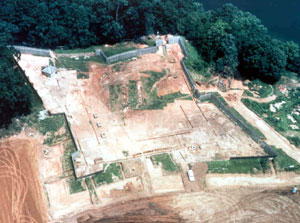
Fort Loudoun
Located in present-day Monroe County, Fort Loudoun was named in honor of John Campbell, the Earl of Loudoun, commander-in-chief of the British forces in North America at the time of the fort’s construction in 1756-57. Interest in building a fort in the territory of the Overhill Cherokees to cement, in both a physical and symbolic sense, diplomatic and trade relationships between the British colonists and the Cherokees, dates to the 1740s. Nothing happened, however, until the great rivalry between the British and French over the control of North America evolved into the Seven Years’ War of 1756 to 1763. Fort Loudoun, designed by engineer John William G. De Brahm, stood on the south side of the Little Tennessee River near its confluence with the Tellico River. Captain Raymond Demeré, who initially commanded the approximately 200 South Carolina militia troops and British regulars stationed at the post, and De Brahm clashed repeatedly over the fort’s location, construction, and design. In a report to the governor of South Carolina, Demeré sarcastically dismissed the fort by observing that the Cherokees “call it the Fort to put Horses, Cows, and Hogs in, but I differ in opinion with them for it would not be sufficient” for even that purpose. (1) While Demeré and his soldiers moved into the fort in early January 1757, he did not consider the fort to be finished until late July. In August 1757, Demeré left, transferring command to his brother Paul.
Fort Loudoun featured a large log palisade, inside of which were a row of barracks, a powder magazine, a blacksmith shop (that also served as a meeting house or chapel), two corn houses, a guardroom, and various storehouses. Officers usually had private dwellings constructed for themselves and their families. Once complete, the fort was meant to be a self-sufficient military outpost on the farthest fringes of the Carolina frontier. But survival, or at least an adequate supply of food, was dependent on friendly relations with the neighboring Overhill Cherokees. Cherokee women, for instance, exchanged very desirable fresh foods, berries, and fish for trade goods. The Native Americans also liked to visit with the soldiers, and they considered the outpost as much their territory as that of the English colonists.
As relations between British forces, the colonists, and the Cherokees worsened during the war, tensions rose at Fort Loudoun. By 1760 mutual suspicion and distrust had replaced the earlier friendly relations. In March of that year the Cherokees laid siege and cut off outside supplies to the fort. On June 10 rations for the soldiers and family members were reduced to a mere quart of corn for every three people; in July, the last bread was consumed. As heat and hunger overwhelmed the fort’s inhabitants in early August, a number of soldiers abandoned their comrades, leaving the officers little choice but to surrender. On August 9, 1760, 180 men, with 60 women and children, left Fort Loudoun to begin a long overland march to South Carolina settlements. A day later, near Tellico Plains, approximately 700 Cherokees attacked the retreating soldiers and their families, killing three officers, 23 soldiers, and three women. The rest were captured and whisked away to Cherokee villages, where a few were murdered but most were ransomed to either Virginia or South Carolina.
Although the garrison and fort were lost in 1760, by that time Fort Loudoun had served its military mission of keeping the Cherokees from supporting the French cause in the early, decisive years of the war. The fort’s history is now commemorated at the Fort Loudoun State Historic Area, which features a replica of the fort as it existed in 1759-60.
Suggested Reading
Carroll Van West, Tennessees Historic Landscapes (1995)



